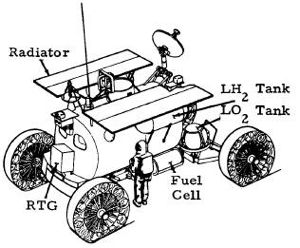
Home - Search - Browse - Alphabetic Index: 0- 1- 2- 3- 4- 5- 6- 7- 8- 9
A- B- C- D- E- F- G- H- I- J- K- L- M- N- O- P- Q- R- S- T- U- V- W- X- Y- Z
MOBEV R2C(1)E
 MOBEV R2C(1)E |
Status: Study 1966. Gross mass: 3,398 kg (7,491 lb).
A seven-day life support contingency, beyond the basic 14 days, was also included in the design. The MOLAB carried 320 kg of scientific payload, and had an average driving speed of 10 km/hr.
The MOLAB was delivered to the moon by a LM-Truck, and was capable of being stored for as long as six months before commencing its mission. Prior to the crew's arrival, the MOLAB was remotely unloaded and driven to the site of the crew's landing. The 14-day mission commenced with the arrival of the crew.
The MOLAB power subsystem consisted of two advanced P&W fuel cells, as well as the small RTG and battery. Each fuel cell assembly was rated at 3. 25 kW maximum continuous power. The fuel cells were activated before the MOLAB was unloaded. Included in the oxygen used for the fuel cells was the metabolic oxygen used by the life support subsystem.
The cabin subsystem included a horizontally-oriented cylindrical cabin containing an airlock, five external viewports, and the crew stations. Controls and displays were provided at the two-position driving cockpit, the scientific station, and the aft emergency driving station located in the airlock. Meteoroid protection was provided by the cabin structure.
The mobility subsystem consisted of four metal-elastic wheels individually powered by a motor and transmission, steering actuators located in the front wheel hubs, and suspension and deployment mechanisms. The mobility subsystem required about 5.5 kW of maximum continuous power to traverse the 50/50 ELMS.
The life support/thermal control subsystem consisted of the crew provisions and the Environmental Control System (ECS). The crew provisions included equipment and expendables associated with the personal needs of the astronauts. The ECS provided pressurization, atmosphere control, cabin and suit temperature control, humidity control, contaminant control, and water management.
The astrionics subsystem was comprised of communication, navigation, and TV equipment's. The communications equipment provided for S-band communications between the vehicle and earth, and for local lunar communications at VHF between the MOLAB and the Command Module, EVA astronaut, or other lunar terminals. The navigation equipment utilized two navigation techniques: a position fix mode, and a dead-reckoning mode. The television equipment included a television camera providing a forward-looking stereo pair; a single, monoptic camera for rear viewing; and three cameras for cabin internal viewing and monitoring.
MOBEV MOLAB/MOBEX SUMMARY
Vehicle Type ----MOLAB---- --------MOBEX------- Configuration RZC(1)E R3CE R3AE R3BE R3DE Crew or Duration 2 Man 3 Man 28 Day 42 day 90 day Delivered Mass (kg) 2975 3231 4909 6923 6930 Scientific Payload (kg) 320 320 700 1500 1500 Crew Supplied Mass (kg) 139 169 222 286 988 Ttl Operating Mass(kg) 3398 3826 5757 7646 8344 Range (km) 400 400 800 1600 3425 Avg Max Speed (km/hr} 10 l0 10 10 10 Obstacle (m) 1.1 1.1 1.1 1.1 1.1 Development Cost ($mn) 307 311 324 326 318 Development Time (mos.) 54 56 56 58 58
Crew Size: 2.
Family: Lunar Rovers, Moon. Country: USA. Agency: NASA, Bendix.
Back to top of page
Home - Search - Browse - Alphabetic Index: 0- 1- 2- 3- 4- 5- 6- 7- 8- 9
A- B- C- D- E- F- G- H- I- J- K- L- M- N- O- P- Q- R- S- T- U- V- W- X- Y- Z
© 1997-2019 Mark Wade - Contact
© / Conditions for Use